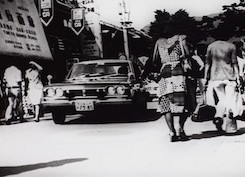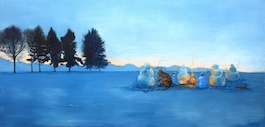“Nostalgia,” a contemporary East Asian art exhibition, opened recently at the Shanghai Museum of Contemporary Art. Presenting works by 14 Chinese, Japanese, and Korean artists, the exhibition puts forward the wish for a certain nostalgia towards the traditional arts — arts that are gradually lost in the process of development as contemporary East Asian art is being influenced by modern Western art.
Born in Korea, lived for years in Japan, and then worked for a Shanghai art institution, the curator of the exhibition, Kim Sunhee, has been active in the promotion of Asian art with over 15 years of experience on the international stage. The identity of someone like Kim Sunhee, with diverse cultural background and experiences, represents exactly the hybrid postmodernity that is borne by a cultural worker in a contemporary globalized society. The title of the exhibition, too, suggests a crisis of identity where self-confidence cannot be ascertained.
On the one hand, she is nostalgic about history and tradition and deplores “the situation in which ways of thinking, traditions and cultures formed over thousands of years are abandoned and replaced by Western civilization.” She hopes to pursue a “path in which East Asian art can occupy an independent place with its own vitality in the international art world.” Yet, on the other hand, the exhibition’s title and selection of artworks again creates the established modes by which the West looks at the East, catering to the powerful Western art authorities. The exhibition takes on “East Asia” in its title along with “nostalgia,” and yet it completely avoids the importance of the politics of history. Thus the exhibition caters to a Western gaze and becomes a pure aesthetic display of exotic Orientalism. This is probably the exhibition’s most serious drawback.
“Nostalgia” refers to an infatuation with the old and the retracing of memories and of a life that has ceased to exist. Such humanistic sentiments oscillate between distinct and indistinct ways of thought: in classical poetry the character “huai” from “huainian” (“nostalgia” in Chinese) can encompass all kinds of emotions and objects between heaven and earth: homesickness (huaixiang), longing for the old (huaigu), longing for mountains (huaishan), and longing for water (huaishui). All that is part of a vanishing history can be brought back to life again in our memories. But there is a price to pay for this revival of history: its first response has a direct connection with pain.
A better counterpart in Chinese to the “nostalgia” in the English title of the exhibition is “huaijiu” (longing for the old). The Latin root nosto represents “going home” while the affixalgos clearly means “pain.” Indeed, the word “nostalgia” first appeared in the medical report of a 17th century medical student from Switzerland. He noticed the intense longing among the Swiss mercenaries for their homeland, and called the “despondency, frustration, and melancholy” thus observed “nostalgia.” From its origins, therefore, nostalgia was treated as a psychological affliction, and the only cure for such an affliction was to return to one’s homeland and to recreate the lost memories. So the title of “nostalgia” manifest this “return,” this desire to recreate memories.

